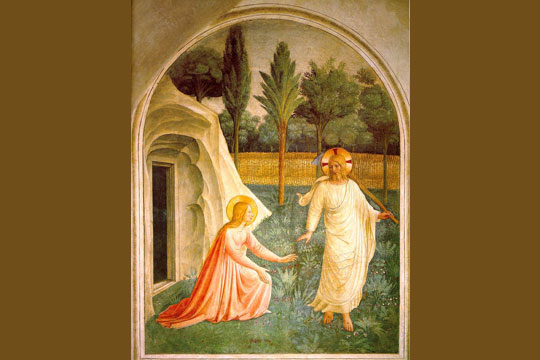
This Wednesday, we celebrate the Feast of St. Mary Magdalene, who for too long has wrongly been labeled as a former prostitute, a label that was reinforced by her portrayal in various Hollywood films such as Jesus of Nazareth, Jesus Christ Superstar, The Passion of the Christ (portrayed as the woman caught in adultery), the 1927 version of King of Kings, Mary Magdalene (TV movie), The Greatest Story Ever Told, and The Last Temptation of Christ.
There is no scriptural basis for this inference of Mary Magdalene as a prostitute.
She appears in four scenes in the Gospels:
- Luke 8:2—Luke describes Mary Magdalene as one of the group of women who were following Jesus and says that seven demons had been cast out of her.
- Matthew 27:56; Mark 15:40; Luke 23:49; John 19:25—All four Gospels describe Mary Magdalene as being present at the Crucifixion.
- Matthew 27:61; Mark 16:47; Luke 23:55—All three synoptic Gospels mention Mary Magdalene as a witness to Jesus’ burial.
- Matthew 28:1-10; Mark 16:1-8; Luke 24:1-11; John 20:1-18—All four Gospels describe Mary Magdalene as a witness to the Resurrection and, in Matthew and John, her encounter with the Risen Christ is described.
In Catholic tradition, we sometimes accept as part of our faith story accounts that are extra-biblical, such as the roles of Mary’s parents, Joachim and Anna, and Veronica, who wiped the face of Jesus. However, in the case of Mary Magdalene, there is no evidence that this tradition has inspired roots. Rather, it appears to be a misguided effort to embellish and dramatize Mary Magdalene’s character by relying on stereotypes (i.e. “If she had seven demons driven out of her, surely one of them was a sexual demon.”).
In honor of the Feast of St. Mary Magdalene this week, July 22, let’s commit ourselves to correcting this unfortunate mislabeling whenever we encounter it in homilies, at Scripture study, or in adult faith formation. Let’s clear the good name of St. Mary Magdalene!
Image: Fra Angelico, “Noli me tangere,” public domain via Wikimedia Commons.



Thanks for posting this beautiful reflection on a wonderful saint who has been so mischaracterized!
You’re welcome, Barbara
Hi Joe,
Ok, so what’s the skinny on Mary Magdalene? Where can I read more about her? Enjoy your writings. Keep it up. Thanks. John
Hi John! Mary Magdalene was recently in the news since Pope Francis “upgraded” her memorial to a feast! While that change won’t be very noticeable to the average person, it does serve to raise her “profile” so-to-speak and bring more honor to her. Here’s the “skinny” on this recent news: http://www.catholicnews.com/services/englishnews/2016/pope-elevates-memorial-of-st-mary-magdalene-to-feast-day.cfm
Hello! Joe Paprocki: I was told there is a story book about Mary Magdalene. What is the most resent book on her… I would like to read more about her. I was also told there was a book about Mary as well. What books are the best to read up on these two women. Because some of the story teller’s I see don’t look to be that re-presentable
Thank you Jennifer
Can anyone help Jennifer out with the title or titles of a story book about Mary Magdalene?
There is short reflection on Mary Magdalene in the last part of Elisabeth Schussler Fiorenza’s “In Memory of Her” (p, 332). She concludes her book with a reflection on “Women as Paradigm for True Discipleship (starting p. 320). Publisher: Crossroad Publishing, New York, N.Y., 1984.
There is off course also the much disputed Gospel of Mary Magdalene (just Google to find it).
It took me a while to find their bibliographical data, but these are two other great reads:
Ricci, Carla. Mary Magdalene and Many Others: Women who Followed Jesus. Trans. from Italian by Paul Burns. Minneapolis: Fortress Press, 1994.
Ricci begins her book by hypothesizing on why women were not heard in the time of Jesus due to a number of social and religious factors that ultimately lead to the establishment of male-dominated texts. She then discusses how Mary became labeled as a prostitute and the further described the conditions that women faced in Galilee during the time of Jesus. The book then examines many of the women who followed Jesus, with prime concentration on Mary Magdalene. This is the best source I found concerning women and the social conditions in Galilee at the time of Jesus and will aid those studying not only Mary Magdalene, but other women followers of Jesus and women in Galilee at that time. Ricci received her doctorate from the University of Bologna.
Schaberg, Jane. The Resurrection of Mary Magdalene. New York: Continuum Publishing, 2002.
Jane Schaberg’s book takes an in-depth look at the life of Mary Magdalene by analyzing and evaluating her presence in early Christian texts and legends. She then looks at Gnostic texts and other sources that were termed heretical and believes that the Gnostic writings were seen this way due to the power struggle between Mary and Peter. She tries to restore Magdalene’s image as a women who was faithful to her teacher to the end and that her labeling over time was due to the threat that a women was too close to Jesus and knew to much. She ends her book with excerpts from John 20 that link Mary as the possible successor to Jesus and the movement that he started. She received her Ph. D. in Biblical studies from Union Theological Seminary.
And of course Susan Haskins’
Mary Magdalen, HarperCollins, London, 1994.
The most fact based and well researched book on Mary Magdalene I found was by Ann Graham Brock, “Mary Magdalene: The First Apostle”.